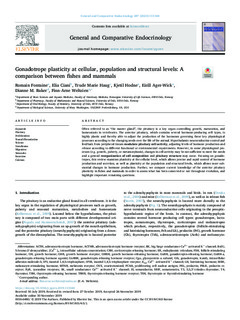| dc.contributor.author | Fontaine, Romain David | |
| dc.contributor.author | Ciani, Elia | |
| dc.contributor.author | Haug, Trude M | |
| dc.contributor.author | Hodne, Kjetil | |
| dc.contributor.author | Ager-Wick, Eirill | |
| dc.contributor.author | Baker, Dianne | |
| dc.contributor.author | Weltzien, Finn-Arne | |
| dc.date.accessioned | 2020-01-03T12:08:07Z | |
| dc.date.available | 2020-01-03T12:08:07Z | |
| dc.date.created | 2019-12-04T12:33:12Z | |
| dc.date.issued | 2019 | |
| dc.identifier.citation | General and comparative endocrinology, volume 287, 1 February 2020, 113344 | nb_NO |
| dc.identifier.issn | 0016-6480 | |
| dc.identifier.uri | http://hdl.handle.net/11250/2634789 | |
| dc.description.abstract | Often referred to as “the master gland”, the pituitary is a key organ controlling growth, maturation, and homeostasis in vertebrates. The anterior pituitary, which contains several hormone-producing cell types, is highly plastic and thereby able to adjust the production of the hormones governing these key physiological processes according to the changing needs over the life of the animal. Hypothalamic neuroendocrine control and feedback from peripheral tissues modulate pituitary cell activity, adjusting levels of hormone production and release according to different functional or environmental requirements. However, in some physiological processes (e.g. growth, puberty, or metamorphosis), changes in cell activity may be not sufficient to meet the needs and a general reorganization of cell composition and pituitary structure may occur. Focusing on gonadotropes, this review examines plasticity at the cellular level, which allows precise and rapid control of hormone production and secretion, as well as plasticity at the population and structural levels, which allows more substantial changes in hormone production. Further, we compare current knowledge of the anterior pituitary plasticity in fishes and mammals in order to assess what has been conserved or not throughout evolution, and highlight important remaining questions. | nb_NO |
| dc.language.iso | eng | nb_NO |
| dc.rights | Attribution-NonCommercial-NoDerivatives 4.0 Internasjonal | * |
| dc.rights.uri | http://creativecommons.org/licenses/by-nc-nd/4.0/deed.no | * |
| dc.title | Gonadotrope plasticity at cellular, population and structural levels: A comparison between fishes and mammals | nb_NO |
| dc.type | Journal article | nb_NO |
| dc.type | Peer reviewed | nb_NO |
| dc.description.version | publishedVersion | nb_NO |
| dc.source.volume | 287 | nb_NO |
| dc.source.journal | General and Comparative Endocrinology | nb_NO |
| dc.identifier.doi | 10.1016/j.ygcen.2019.113344 | |
| dc.identifier.cristin | 1756536 | |
| dc.relation.project | Norges forskningsråd: 243811 | nb_NO |
| dc.relation.project | EC/H2020/642893 | nb_NO |
| dc.relation.project | Norges forskningsråd: 244461 | nb_NO |
| dc.relation.project | Norges forskningsråd: 248828 | nb_NO |
| cristin.unitcode | 192,16,1,0 | |
| cristin.unitname | Institutt for basalfag og akvamedisin | |
| cristin.ispublished | true | |
| cristin.fulltext | original | |
| cristin.qualitycode | 1 | |

